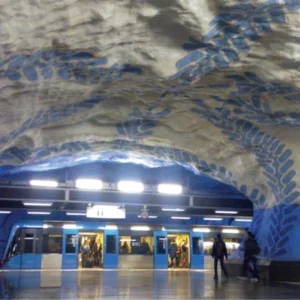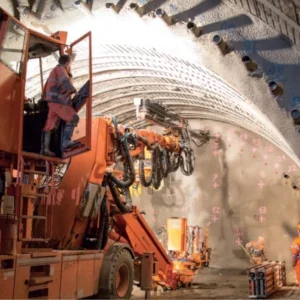The 11th International Symposium on Tunnel Safety and Security 2025 (ISTSS) will be held over 9-11 April in Reykjavik, Iceland.
The event considers developments and technology in all aspects of underground works and facilities, ranging from tunnels, shafts and caverns to metros, mines and garages, which the organiser, Sweden’s RISE research institute, notes “are increasingly important parts of societal infrastructure worldwide.”
ISTSS 2025 takes place in conjunction with, and follows, the 8th International Conference on Fire in Vehicles (FIVE), 7-8 April.
The complementary events first, at FIVE, brief of electric vehicles, batteries, alternative fuels and a range of risks and safety measures; then, second, at ISTSS, put such details along with many other types of vehicles into the wider setting of fire safety in transport tunnels (road, rail, metro) and other underground facilities.
FIVE – AGENDA
The two-day programme for the 8th International Conference on Fire in Vehicles (FIVE) will cover the following themes:
DAY 1 (7 APRIL)
Keynote
EV guidelines
Battery fires
Safety of Alternative fuels
EV fire suppression
DAY 2 (8 APRIL)
Keynote
Car park fires
Fire development
Fire incidents
Concluding Remarks
On the first day, planned presentations include:
- Operational guide for rescue operation involving lithium-ion batteries
- Safety guidelines for battery swap station
- Data to pre-empt EV battery fires due to manufacturing faults
- Experimental investigation of fire with multiple battery EVs in a storage setting
- Different triggers of thermal runway propagation in large-format lithium-ion battery modules
- Electric shock from a burning or crashes vehicle – risk assessment
- Hydrogen storage system for vehicles
- Performance evaluations of fire suppression for fullscale tests with EVs
ISTSS 2025 – PROGRAMME
The three-day technical programme for ISTSS 2025 is as follows, with the titles of the planned presentations. Note that the first day has sequential talks while second days runs parallel tracks:
DAY 1 (9 APRIL)
Opening
- Road map of tunnel fire research
- Explosion hazards of vehicles with new energy carriers in tunnels and underground spaces
Session: Fire Dynamics
- Numerical study of the influence of wind on the smoke spread between underpasses
- Improved model of smoke layer thickness in naturally ventilated tunnel fires considering the effects of aspect ratio
- Study on the indoor-outdoor temperature differenceinduced smoke re-stratification in naturally ventilated tunnel fires
- Vehicle impact on smoke stratification
Afternoon
Session: Fixed Fire Fighting Systems (FFFS)
- Laboratory scale tests of FFFS and emergency ventilation interaction for highway tunnels
- Comparison of water-based FFFS for road tunnel application
- Study findings of water-based FFFS in tunnels
Session: Alternative Fuel Vehicles
- Preventing and managing NEC incidents in tunnels: safety concepts
- Explosion consequences in a tunnel: experimental evaluation of hydrogen leaks
- In-tunnel LIB cargo fire emergency and impacts on tunnel operational capability
Session: Posters
DAY 2 (10 APRIL)
Session: Keynote & Evacuation
- Evacuation and human behaviours in tunnel fires
- Flame behaviours and smoke transport in urban road tunnel fires under natural ventilation conditions
- Numerical investigation of the effects of ventilation on the tenability of egress paths in a metro tunnel fire
- Ventilation and Fire Life Safety upgrades to an existing rail tunnel facility considering modern requirements
Session: Evacuation (parallel track 1)
- Disposal of emergency telephones in Swedish rail tunnels: practical application of the CSM RAregulation
- Safety enhancement by introduction of evacuation assist of light for long distance road tunnel fires
- Tunnel safety, requirements for self-rescue and evacuation – the(mis)use of traffic volume to define the level of safety
- A modified approach to walking speed within smokefilled rail tunnels
Session: Ventilation (parallel track 2)
- Cross River Rail – innovations in metro tunnel ventilation and Fire Life Safety
- Fire smoke control ventilation at portals in rail tunnel groups affected by canyon wind
- Smoke management, differential pressures on egress doors and controls during fire evacuation in metros
- Tunnel ventilation in India: state-of-the-art and evolution
Afternoon
Session: Fire Dynamics (parallel track 1)
- Experimental study on smoke temperature and carbon monoxide diffusion of channel fires under the synergistic action of air curtain and lateral centralised smoke exhaust
- A parametric study of fire conditions in naturally ventilated road tunnels
- Comparison of Ansys Fluent and FDS for modelling smoke movement in tunnel fire scenarios
- Impact of external wind with upward and downward angles on smoke layer development in tunnel fires
Session: Engineering Case Studies (parallel track 2)
- When is a tunnel a tunnel?
- Use of a risk model to evaluate tunnel safety features
- Reykjavik’s Saebraut road tunnel: balancing development and safety
- The Ferney cut-and-cover tunnel: specific challenges
Break
Session: Risk Management (parallel track 1)
- Managing disaster risks in underground transportation infrastructure – a comprehensive analysis of safety targets and practices
- Using deep learning to predict traffic dynamics in road tunnels
- South Korean case study of QPA approach to road tunnel fire safety
Session: Emergency Management (parallel track 2)
- Dutch road tunnel firefighting in the future: a firefighter’s perspective
- What fore modelling resolution is needed in AI training data for smart firefighting in tunnels?
- Review of emergency egress and rescue challenges in rail tunnels a responder’s perspective
DAY 3 (11 APRIL)
Session: Keynote & Risk
- Engineering practice of tunnel fire safety
- Structural safety in tunnel fires
- Importance of human factors in emergency: learning from past disasters
- Evolution of a risk indexing method for evaluating safety in Swedish rail tunnels
Session: Engineering Case Studies
- Rehabilitation of Fire Life Safety systems for existing tunnels
- CFD modelling of the Memorial Tunnel fire tests using autonomous meshing approach and adaptive mesh refinement
- Examining tunnel safety features in sustainability-led design
- Implications pf peak heat release rate to optimise metro tunnel ventilation systems
Lunch
Session: Panel Discussion
Concluding Remarks
EVOLUTION OF ISTSS
The International Symposium on Tunnel Safety and Security (ISTSS) has its origins in creating a forum to share test findings from the disused Runehamar road tunnel, in Norway. The fire safety tests took place than 25 years ago and the presentation event – then called the International Symposium on Catastrophic Tunnel Fires – took place in late 2003, in Borås, Sweden.
The organiser was SP Technical Research Institute of Sweden, now known as RISE.
RISE says that the appetite for such information and data led to higher than originally expected numbers of delegates, and there was such a demand for “continued dialogue” that follow up symposia were there result – becoming known under the ISTSS banner from the second event, in 2004, through US collaboration.
“The success of the ISTSS is a tribute to the pressing need for continued international research and dialogue on these issues, perhaps in particular connected to complex infrastructure such as tunnels and tunnel networks,” says RISE.
While noting the focus has been on fires and safety in tunnels, it observes a shift that is bringing in more discussion on security.
“Solutions to new energy carriers and antagonistic threats are becoming increasingly important,” says RISE. It adds, “The need for expertise about these issues for underground infrastructure is continuously increasing.”






